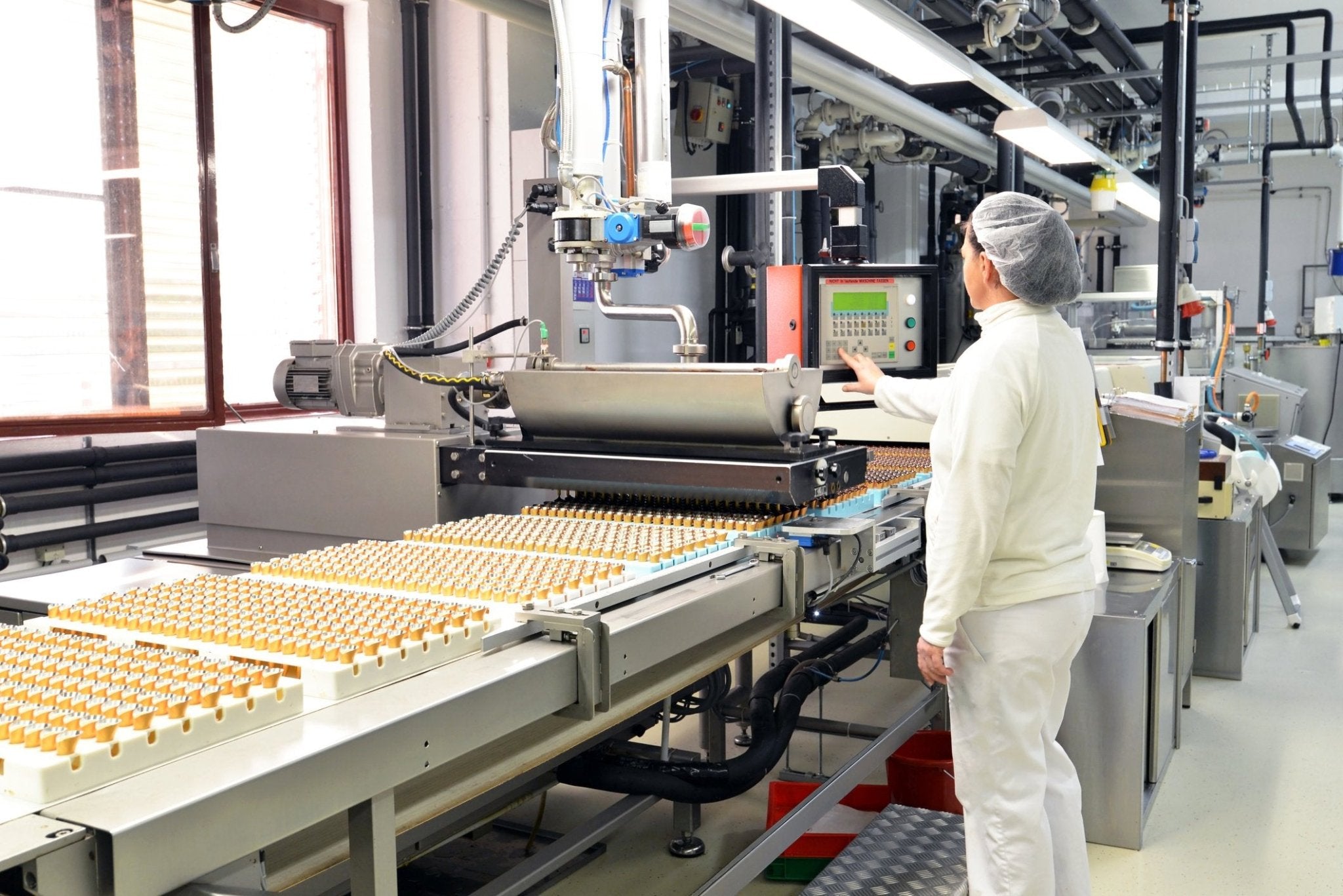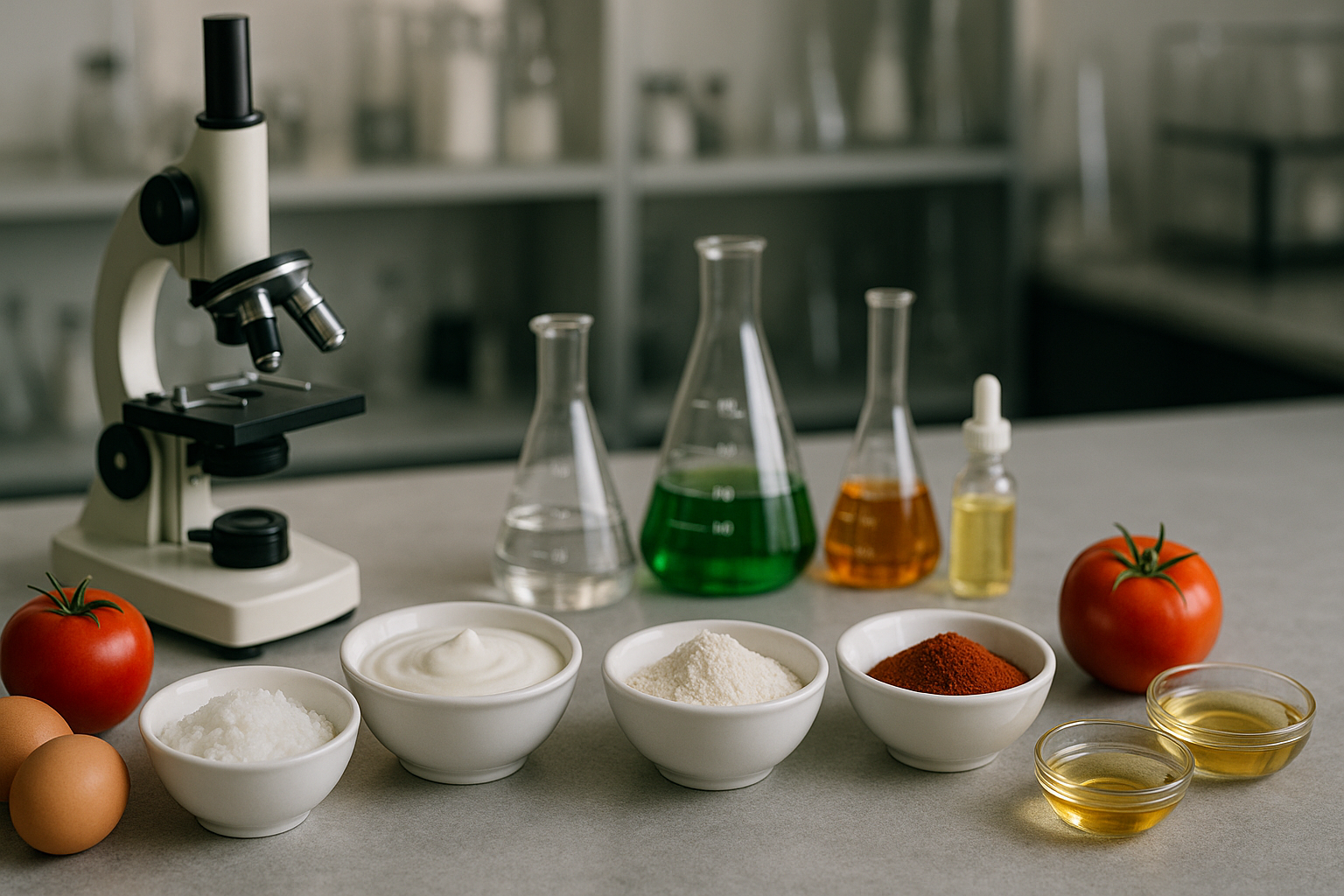
Exploring Hydrocolloid Wiki: A Comprehensive Guide
SUBSCRIBE TO OUR BLOG
Promotions, new products, and recipes.
ABOVE: Hydrocolloids are important ingredients in the production of foods, cosmetics, and pharmaceuticals.
Dive into the exciting universe of hydrocolloids and find out how they are used in food, cosmetics, and medicine. This blog post will provide an insight into different types of this versatile material along with their applications as well as cutting-edge trends shaping its future. So let’s embark on our journey to discover more about these extraordinary substances through our own little ‘hydrocolloid wiki’!
Key Takeaways
-
Hydrocolloids are versatile and used in food, skincare, and wound care.
-
Learn how to manipulate pH, temperature, and additives for optimal performance.
-
Discover the future of sustainable hydrocolloid alternatives with microbial fermentation and biotechnology!
Understanding Hydrocolloids
Hydrocolloids can be considered the Swiss Army knife of substances. They are capable of so many things! With a broad portfolio ranging from their role in thickening food to cosmetics, pharmaceutics, and gel-forming agents for wound care. Gelling is achieved by randomly scattering polymer segments into dispersion that creates an interlocked 3D network holding solvent which allows hydrocolloid gels to form. For this reason, these versatile substances have become very popular across various industries. Whether it’s creating texture or healing acne with protective barriers, hydrocolloid dressings provide innumerable benefits within multiple disciplines that ensure its lasting success.
Types of Hydrocolloids
HYDROCOLLOID APPLICATIONS TABLE
| APPLICATION | Baked Goods |
Dressings, Sauces, Tomato-based Products |
Non-dairy Beverages |
Dairy | Confec- tionary |
Meat Products |
Batter and Breaded Coatings |
Processed Fruit |
Fat Replacers |
|
| HYDROCOLLOID | ||||||||||
| Agar agar | X | X | ||||||||
| Carrageenans | X | X | X | X | ||||||
| Cellulose gum | X | X | X | X | X | |||||
| Gelatin | X | X | X | X | ||||||
| Gellan gum | X | |||||||||
| Guar gum | X | X | ||||||||
| Gum Arabic | X | X | X | |||||||
| Gum karaya | X | |||||||||
| Gum tragacanth | X | |||||||||
| Hydroxypropylcellulose | X | X | ||||||||
| Konjac flour | X | |||||||||
| Locust bean gum | X | X | X | |||||||
| Methylcellulose | X | X | X | X | ||||||
| Microcrystalline cellulose | X | X | X | X | ||||||
| Pectin | X | X | X | X | X | X | X | |||
| Propylene glycol alginate | X | X | ||||||||
| Sodium alginate | X | X | X | X | ||||||
| Tara gum | X | X | ||||||||
| Xanthan gum | X | X | X | X | X |
Hydrocolloids have a range of features, including structure, form, and texture. These unique substances are employed to modify rheology and generate physical transformation within the food industry. Examples like guar gum, xanthan gum, or alginate are polysaccharides with an elevated molecular weight that can serve as thickeners or gel-forming agents for gelling applications. The junctions from these hydrocolloid gels create dissimilarities in terms of characteristics -carrageenan is more robust than sodium alginate under similar conditions while being used in different fields such as dessert manufacturing or skin care production respectively
When opting for either type of hydrocolloids one must be mindful of how it will affect their recipe outcomes since every choice comes along with its own set of advantages!
Sources and Extraction
From microbial fermentation to plant seeds and even fish, hydrocolloids can be found in many natural sources. This wide range of elements holds distinct properties that allow them to have a variety of applications all around us. Gelatin from proteins derived by mammals or fishes, pectin extracted from citrus peel and apple waste, agar-agar plus carrageenan obtained from seaweed are just some examples that make this product indispensable nowadays. Thanks to these unique components, they continue being part of multiple industries as well as daily products we use every day for our wellbeing.
Hydrocolloids in the Food Industry
| SOURCE | TYPE | |
| Plant-Based | From Seeds Guar Gum, Locust Bean Gum, Tamarind Gum, Linseed Gum |
|
| From Tree Sap Gum Tragacanth, Gum Karaya (Sterculia gum), Gum Arabic (Acacia gum), Yarrow Gum, Peach Gum |
||
| Other Plant Sources Pectin, Konjac Gum, Aloe Vera Extract, Inulin, Xanax Polysaccharide |
||
| Animal-Derived | Gelatin, Casein, Sodium Caseinate, Chitin, Chitosan, Whey Protein Isolate | |
| Whey Protein Concentrate, Fish Gum | ||
| Microbial Based | Xanthan Gum, Gellan Gum | |
| Coagulated Polysaccharide, Yeast Polysaccharide | ||
| Seaweed Based | Agar Agar, Carrageenan, Alginate, Propylene Glycol Alginate (PVA), Red Algae Gum | |
| Brown Algae Salt Alginate | ||
| Synthetic | Gellan Gum, Sodium Carboxymethyl Cellulose, Hydroxyethyl Cellulose, Microcrystalline Cellulose, Methyl Cellulose, Hydroxypropyl Methyl Cellulose, Hydroxypropyl Cellulose, Modified Starch, Sodium Polyacrylate, Polyvinylpyrrolidone | |
The food industry has long relied on hydrocolloids to bring textural qualities, viscosity, and stability to their products. Locust bean gum and guar gum for example are fast-acting thickeners that can work wonders in sauces or dressings. Starch is a staple as far as thickening agents go -but gelling properties also come into play when it comes to the many applications of this element within food production. Not only do these elements give desirable textures but they guarantee quality results too! Hydrocolloids are indispensable tools to ensure both texture and stabilization in any recipe. Making them an obvious choice whenever one needs proper ‘thickness’ without compromising taste or product integrity
Factors Affecting Functionality
The food industry relies heavily on the use of hydrocolloids for a variety of purposes, where various factors are responsible for their functionality. Concentration and temperature levels will determine if the solution is thicker or thinner - while pH level, light exposure, oxygen availability as well and enzymatic activity all work together to ensure product quality and lasting stability. It’s essential that these elements be monitored correctly in order to achieve desired results within any given formulation involving foods and beverages alike. In other words: grasping these different variables can play an integral role when it comes to attaining optimal performance throughout each product’s lifespan in this highly competitive sector..
Popular Food Applications
Hydrocolloids are frequently used in food processing for different purposes, such as providing a more desirable texture and improving the viscosity of particular items. They can be found performing gelling functions in desserts like puddings and acting as thickening agents to thicken sauces or dressings. They serve as stabilizers for dairy products and other bakery goods.
The interest concerning healthier yet sustainable types of food has increased significantly lately resulting in an increasing demand for hydrocolloid utilization across the food industry from restructured fruits and vegetables up to cold-prepared creams & fruit preparations – making them essential components when creating high-quality meals.
Hydrocolloid Acne Patches and Wound Healing
Hydrocolloid acne patches and wound dressings are extremely advantageous when it comes to promoting healing while providing protection against infection. These items rely on the moisture-absorbing, shielding effects of hydrocolloids in order to facilitate faster recovery times, reduce swelling, and avoid permanent scarring. Hydrocolloid patches can be especially effective for treating persistent breakouts or pimples.
Let’s take a closer look at how these particular products which contain hydrocolloids execute their healing properties efficiently by speeding up the recuperation process from either an irritation or injury situation.
Acne Patch Technology
Hydrocolloid acne patches are a popular way to treat acne, due to the beneficial properties of hydrocolloids - protective sealing of skin, absorbing excess fluid from blemishes, taking out oil and bacteria inside pimples. These can offer an ideal environment for wound healing as well. Depending on the type of patch material used (hydrocolloid), size & duration applied. Results may vary but such treatments have become reliable solutions for various skin issues promoting overall health.
Wound Healing with Hydrocolloid Dressings
Hydrocolloid dressings, like a gel that can absorb moisture and create an effective barrier around the wound site, are a must-have medical tool for healthcare providers and patients alike. They offer several benefits in terms of healing. They reduce inflammation by creating favorable conditions for faster healing while also reducing pain and minimizing scarring.
There is quite an array of hydrocolloid dressings available. Foam, alginate, or hydrogel to name but a few depending on how severe your particular injury may be. Each provides distinct advantages pertinent to one individual need when it comes to facilitating optimal wound recovery via its ability as regards effectively assist in this vital process known as ‘wound healing’.
Colloid Particles and Stability
Colloid particles and hydrocolloids can form either stable or unstable systems, depending on the forces between them. This has an impact on the viscosity properties of these types of mixtures which are necessary for a range of fields such as food production, cosmetics manufacturing, and pharmaceuticals.
Understanding how colloidal components interact with each other enables us to manage stability in order to meet specific requirements across different applications. Thus understanding their interactions becomes crucial. By controlling this dynamic process we will be able to create optimal conditions that take into consideration both stabilization techniques as well destabilization solutions when it comes to working with colloid particles and hydrocolloids.
Interaction between Colloid Particles and Hydrocolloids
Understanding the link between colloid particles and hydrocolloids is essential when designing products or formulations using them. This is due to their impact on characteristics such as viscosity, texture, and stability of the system - all of which can be altered depending on parameters like size, charge concentration, etc.
By tailoring these properties precisely for our applications we are able to guarantee that our final product will have optimum performance while keeping its durability across shelf life. Something achievable only with a thorough understanding of how colloidal particles interact with hydrocolloids
Methods for Stabilization and Destabilization
Two main methods, electrostatic stabilization, and steric stabilization, are employed to avoid the agglomeration of colloid particles. By understanding these techniques and applying them correctly in a hydrocolloid system, one can achieve the desired stability as well as enhanced functionalities for its various applications. pH level adjustment along with temperature control or the addition of additives also aids in stabilizing or destabilizing colloid particle systems depending on needs.
Rheology and Texture of Hydrocolloid Systems
The rheological properties and texture of hydrocolloid systems are highly important in product development as well as quality control. To ensure that products meet the desired characteristics while also preserving their integrity for an extended period, it is essential to measure and analyze these hydrocolloids’ rheology and texture traits. Here we will look into some methods used for this purpose and factors influencing the said parameters.
Different techniques exist when it comes to measuring and exploring how a given system composed of hydrocolloids reacts under different conditions. All delivering vital information needed during both production design stages but also ongoing maintenance operations throughout its shelf life so as to guarantee its standard remains intact at any time or circumstance considered necessary if kept accordingly with specified limits previously set up from before outlined on schedule whether internally regulated externally supervised depending each situation on case basis.
By using dynamic oscillatory rheometry, creep tests, and stress relaxation tests to measure the viscosity, elasticity, and plasticity of materials’ functional properties we can gain an in-depth understanding of hydrocolloid systems. Such information is very useful for tailoring the required characteristics such as physical properties that will enable products to work at their optimum level when a force is applied. By properly analyzing these rheological measurements on various types of materials it allows us to customize them into having specific qualities which are necessary for different applications.
Factors Influencing Texture
Hydrocolloids are key to achieving the desired texture and stability in products, which can be altered by a range of factors. These include concentration, temperature, shear rate (all affecting viscosity and elasticity) as well as any other co-solutes present.
By controlling these variables when formulating with hydrocolloids we ensure consumer satisfaction with our finished product. Its good looks and longevity on shelves are guaranteed for maximum success! Knowing how each factor impacts texture is critical to creating formulations that meet expectations for performance quality while maintaining their unique properties over time.
Innovations and Future Trends in Hydrocolloids
With consumers increasingly expecting responsible and sustainable products, the development of eco-friendly hydrocolloids has become a priority. To meet this need, many innovative trends have emerged which explore biotechnology and microbial fermentation. These advancements offer potential for new applications within various industries while minimizing environmental impact.
Biotechnological developments in particular can provide us with more sustainable hydrocolloid options that are able to exploit microbes or utilise natural sources such as plant extracts to create functional materials without sacrificing quality or safety standards. It is clear that these advances could give rise to exciting opportunities in the future of hydrocolloids!
Microbial Fermentation and Biotechnology
Microbial fermentation and biotechnology present exciting opportunities for creating renewable hydrocolloids with enhanced functionality that is gentler on the environment. Through these methods, we can develop ingredients that boast higher nutritional values as well as specialized functional elements that have multiple applications within food, pharmaceutics, and other industrial sectors. This innovative approach offers a chance to devise novel biological technologies in order to produce sustainable results. Consequently, microbial fermentation along with biotechnological innovation provides us ways of obtaining improved hydrocolloids going forward.
Sustainable and Eco-friendly Hydrocolloids
As consumers become increasingly aware of environmental responsibility, sustainable and eco-friendly hydrocolloids are becoming more sought after. Such colloids use biodegradable plant sources rather than traditional ones in order to reduce their impact on the environment. Not only that, but these new-generation hydrocolloid options also promise improved quality as well as cost savings for manufacturers. With researchers investing In this field all the time, there will be even more environmentally friendly choices available soon enough.
Summary
Hydrocolloids have come to be known as the Swiss Army knife of substances due to their highly versatile range of applications, particularly in the food industry. From acne patches and wound dressings, these materials prove invaluable for everyday use while also pushing forward sustainable solutions and biotechnology innovations. As we look ahead at how hydrocolloid technology can continue making a positive impact on our lives, it’s exciting to think about what new advances may arise from this incredible resource!
Frequently Asked Questions
What does hydrocolloid do for the skin?
Hydrocolloid dressings are a form of treatment to aid skin healing by creating an isolated, moist environment. Hydrocolloid particles in the dressing absorb exudate and convert it into gel which acts as insulation for wounds while encouraging your body’s natural enzymes to regenerate healthy skin tissue.
When should you not use a hydrocolloid dressing?
A hydrocolloid dressing should not be used on a wound that has had its roof removed if it is oozing fluid, necessitates frequent monitoring, or contains an infection in need of draining. These injuries call for more regular changes to dressings and the protection offered by a hydrocolloid will be insufficient.
Why do hydrocolloid bandages turn white?
Notice your hydrocolloid bandage turning white. Don’t worry, it’s just doing its job - absorbing the wound fluid!
Hydrocolloid dressings keep wounds moist and protected, meaning less need for cleaning them.
Why do hydrocolloid bandages work so well?
Hydrocolloid dressings are ideal for wound care as they help to form a gel-like covering, which helps protect the area and encourage healing. The material absorbs any exudate produced by the injury while creating an optimal moist environment for successful recovery. This type of bandage is considered highly effective in treating wounds since it shields against harm and keeps new tissue secure during treatment.
What are the main applications of hydrocolloids in the food industry?
Hydrocolloids are highly utilized in the food sector to bring about a desirable texture, as well as gelling and thickening agents for added stability of sauces, dressings, and other foods. They have become ubiquitous ingredients because they deliver these effects widely.


|
About the Author Ed is the founder of Cape Crystal Brands, editor of the Beginner’s Guide to Hydrocolloids, and a passionate advocate for making food science accessible to all. Discover premium ingredients, expert resources, and free formulation tools at capecrystalbrands.com/tools. — Ed |
Enjoyed this post? Subscribe to The Crystal Scoop
Food-science tips, ingredient know-how, and recipes. No spam—unsubscribe anytime.
- Choosing a selection results in a full page refresh.



